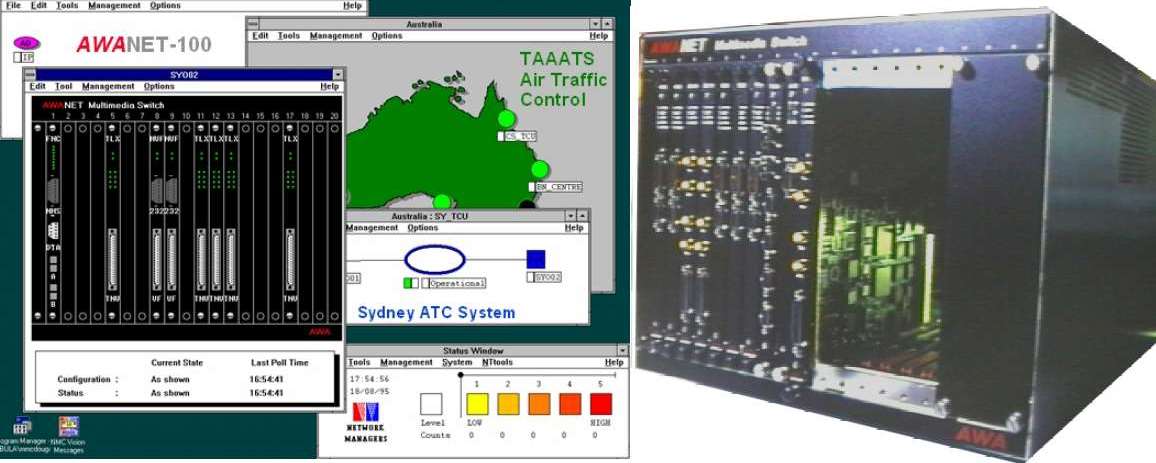|
Projects
|
The following Projects 6 - 10 are some of the most interesting and professionally
rewarding product & systems development projects that Haltec Enterprises'
Director, Ross Halgren has been involved in and had a significant influence
on. The first two projects outlined below were initiated by AWA Defence &
Aerospace and handed over to AWA Communications in 1997 since the core FDDI-2
technologies and the AWANET-100 & MILNET-2000 products were perceived to
have greater value for a wider range of communications applications. At around
that time, AWA Defence Industries was sold to British Aerospace and AWA Communications
was sold to Plessey of South Africa. Whilst the AWA management layers were in
a state of flux, the engineering and product management layers were kept in
tact to enable the ongoing success of the technology, associated products and
systems. Unfortunately, the above structural changes eventually thwarted the
full commercial benefits of the AWA technologies from being realised. In fact,
the AWANET-100 and MILNET-2000 products would have had a better fit with British
Aerospace, especially given that they were the prime contractor for the RAF
NIMROD-2000 coastal surveillance aircraft upgrade program.
|
Project
1
|
Project
2
|
Project
3
|
Project
4
|
Project
5
|
Project
8
|
Project
9
|
Project
10
|
Project 6 - In 1996, AWA Defence & Aerospace delivered under contract to Thomson-CSF and Air Services Australia, the first of several AWANET-100 based Voice Switching & Control Systems (VSCS) for The Australian Advanced Air Traffic System (TAAATS). TAAATS included two major Air Traffic Control (ATC) centres in Brisbane and Melbourne which were configured as redundant back-ups for each other, together managing 10% of the world's air-space. The VSCS part of the system managed and switched voice communications between all aircraft in the Australasian region and the ATC console operators in Brisbane, Melbourne and other major city ATC centres. As a result of this project, Thomson-CSF formed a co-operative relationship with AWA and as they better understood the fibre-optic and hybrid switching capabilities of the FDDI-2 and AWANET-100 technologies, they commenced technical discussions regarding the merging of their own proprietary and somewhat older VSCS technologies with AWA's new, standardised switching technologies. To this end, Thomson-CSF's VSCS product manager Georges Berry was seconded to Sydney to understand AWA's technology capabilities and Ross Halgren was seconded to Paris to understand Thomson-CSF's technology capabilities. Further to this, the discussions were extended to include the development and integration of Aeronautical Telecommunications Network (ATN) technologies. As a result, additional AWA Defence & Aerospace engineers were brought into this R&D project.
 |
 |
|
|
AWANET-100 Network Management Screen & AWANET-100 Multimedia
Packet & Circuit Switch
|
TAAATS
Workstation and AWANET VSCS Screen
|
Project 7 - The effort that AWA invested in the New Construction Submarine project did not entirely go to waste. The loss of this project did not deter AWA from developing a MILNET product for military communications applications. In 1987, AWA revisited the design options and found that a new 100Mbit/s fibre-optic FDDI-2 standard was emerging within ANSI that was very similar in its hybrid switching ring architecture to AWANET and MILNET. Additionally, the US Navy SAFENET standards for data networks were adopting its predecessor, FDDI-I. As a result, Ross Halgren joined the ANSI X3T9.5 Standards Committee in the USA to influence the FDDI-2 standard and his team at AWA commenced the development of the FDDI-2 technology, in the form of chip-sets, circuit boards and software. The FDDI-2 technology was then targeted at upgrading AWANET-30 to AWANET-100 for enterprise and civil applications; and to MILNET-2000 for military applications, such as Navy ships. AWA received Defence Industry Development (DID) support for the FDDI-2 technology development. In the case of AWANET-100, a full system of interface cards was developed. In the case of MILNET-2000, effort focused on a triple-standard "FMVS" interface card supporting FDDI-2 on the network side and VME for packet data and SCSA for audio and video on the backplane side. As a result of this fully standardised approach, AWA won major supply contracts to STE&E to provide a FDDI-2 backbone for their Shipboard Integrated Communications System (SiCS) for Singapore Navy Ships and Telephonics in New York as a fibre-optic backbone upgrade to their TCOMSS Airborne Communications Management System, first for the RAF NIMROD2000 mid-life upgrade and subsequently for other military aircraft upgrades. For airborne applications, General Dynamics also adopted AWA's FDDI-2 card for interfacing to their Mission Data Recorders.
 |
 |
|
MILNET-2000
SiCS and TCOMMS Applications
|
NIMROD-2000
Application
|

Page 3 of 4